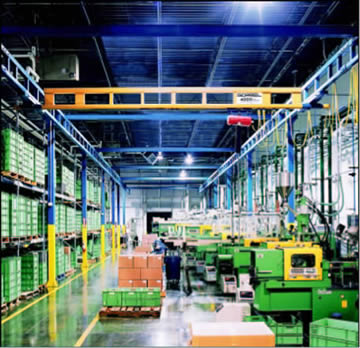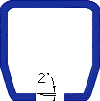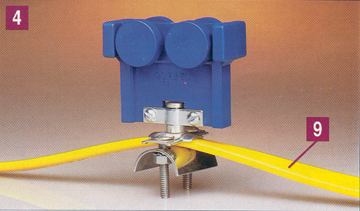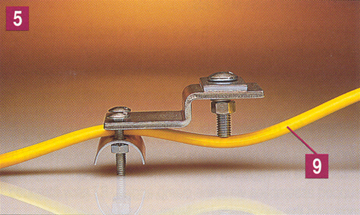Back to Product Page
|
Free
Standing Work Station
Bridge Cranes
|
|
|
|
|
|
| |
| |
|
|
|
|
|
The
safe, productive, ergonomic solution for
overhead materials handling operations.
|
|
Enclosed
Track Design Makes for Easy
Movement and Long Life |
|
|
|
|
|
|
|
|
 |
|
The
steel Work Station Crane System utilize enclosed
track that is high in strength and low in weight. Major
advantages:
• Enclosed track cranes are up to three times easier to
move than traditional bridge cranes.
• The design virtually eliminates dirt and dust from the
rolling surface, thus reducing wear on the wheels
of
the trolley and end trucks.
• The smooth running surface means lower rolling
resistance.
• The low profile of the steel track allows the system
to be installed where headroom is a problem.
• The low track weight reduces the applied forces
exerted on the supporting structure.
• Long spans allow systems to be installed where
support assemblies are infrequent (up to 30 feet
with
steel truss design). This reduces the possibility
of the
support columns interfering with the work cell
layout.
• Four distinct sizes of track -- 250, 500, 1000, and
2000 series -- enable you to keep bridge weights
and costs to a minimum. |
|
|
|
|
|
Pricing
and Dimensional Specifications -
Click a Load Capacity Link Here |
|
|
|
|
|
|
|
|
|
|
|
|
|
| |
|
|
|
|
|
|
|
|
|
|
 |
 |
|
|
|
|
|
|
| |
|
|
|
|
|
|
|
|
|
Rigid
Runways Provide for Superior
Positioning of Loads |
|
|
|
|
|
|
|
|
|
|
 |
|
The
2° taper of the running
flange helps to center the
trolley in the track for smooth,
effortless movement of trolleys
and end trucks. |
|
|
Work Station Bridge
Cranes are installed so that the
runways are rigid. They do not move laterally or
longitudinally. In addition, the floating end trucks with
horizontal wheels prevent binding. The combination of
these design features results in unmatched ease of
positioning and ease of movement. The bridge travels
smoothly down the runways, and movement is unvarying
along the way, no matter where a load is positioned on
the bridge. This allows superior load positioning.
Another advantage of rigid runways is that runways
double as stringers between support columns. This
eliminates the need for expensive intermediate support
stringers, and it lowers overall installation cost.
|
|
|
|
|
|
|
|
|
|
|
|
|
|
|
|
 |
|
|
|
|
|
|
|
|
| What
is meant by Rated Capacity? |
|
|
|
|
|
|
|
|
|
|
|
|
|
The
rated capacity is the live load that can be lifted by
the crane system. The design load for the crane system
is based on the rated capacity plus 15% for the weight
of the hoist and trolley (capacity x 1.15) and an additional
25% for impact (capacity x 1.25) for a total design of
capacity x 1.4 (Note, 25% impact factor is good for
hoist speeds up to 50 f.p.m.). For example, a 1000 lb.
crane allows you to pick up a 1000 lbs. load, provided
the hoist weights 150 lbs. or less and the hoist speed is
less than 50 feet per minute. |
TRUSSED
STEEL TRACK: |
|
|
|
|
|
|
|
|
Permits
longer spans which allows more flexibility
in crane layout. |
|
|
|
|
|
|
|
|
|
The trussed series
uses the plain steel track profile but is
enhanced for longer spans via a built-up truss design. This
design increases the span, which decreases the need for
frequent hangers. Model numbers start with: GLCS-FS
for spans up to 20 feet, GLCSL-FS for spans up to 25
feet, and GLCSLX-FS for spans up to 30 feet.
Long spans translate into fewer runway support points,
less interference of work cell layout, longer bridge lengths,
and free standing capabilities... just another reason why
these Work Station Cranes are among the most versatile
to apply and easiest to install in the industry.
|
|
|
|
|
Design
load for deflection calculations is based on
the rated capacity plus 15% for the weight of the hoist
and trolley (capacity x 1.15). Under no conditions should
the crane be loaded beyond it rated capacity. Work
Station Cranes meet or exceed the ANSI B30.11
specifications for underhung bridge cranes. |
|
|
|
|
|
|
|
|
|
|
|
| |
|
|
|
|
|
|
|
|
|
|
|
|
|
|
| Mixed
Capacity Bridge Crane Systems: |
|
Easy
to Install |
|
|
|
|
Reduced
bridge dead weight equals better ergonomic
solutions. |
|
Free
Standing Work Station Bridge Cranes can be
installed on any normal 6" reinforced concrete floor.
Each column is anchored by four bolts, thus eliminating
the need for field welding.
Support columns are designed to AISC specifications. If
no movement of the support assemblies is required, then
bracing to the building is recommended (not included). |
|
|
Mixed-capacity
systems allow multiple lower capacity
bridges to be used on higher capacity runways, provided
the equivalent center loads (ECL) are verified at the
factory to ensure that runways and hangers are not
overloaded. For example, using mixed-capacity end
trucks, four 500 lb. bridges (utilizing 500 series rail)
can be hung from a 2000 lb. runway, allowing side-by-
side use of all four bridges without overloading the
system. By mixing bridges of various sizes and cap-
acities, mixed-capacity systems offer reduced bridge
dead weight, easier movement, and reduced cost. |
|
|
|
|
|
Modular
Design |
|
The
pre-engineered modular kit design permits easy
expansion or relocation. The runway length can be
increased by adding runway sections, free standing
support assemblies and additional bridges as needed. |
|
|
|
|
Pricing
and Dimensional Specifications -
Click a Load Capacity Link Here > |
|
|
|
|
|
|
|
|
|
|
| |
|
Anatomy
of a Work Station Crane
|
 |
|
|
 |
|
|
|
|
|
|
|
|
1 |
|
HOIST
TROLLEYS |
|
Hoist
trolleys provide the connection between the lifting
device and the monorail. The trolleys are designed for
effortless movement along the track. The stamped body
fits most rigid hook or eye lifting devices. |
|
|
•
Wheels are tapered to match the 2° taper of the track.
This reduces rolling resistance and wheel
wear. Wheels
contain ball bearings that are sealed and
lubricated for
life.
• Trolleys are designed to operate in temperatures from
+5° F to +200° F.
• All trolleys meet or exceed the ANSI B30.11
specification for underhung bridge cranes. |
|
|
|
|
|
|
|
|
|
|
|
2
|
|
END
TRUCKS |
|
|
End
trucks provide the connection between the bridge
and runways. They are designed for effortless movement
along the runway.
• Wheels are tapered to match the 2° taper of the track,
which reduces rolling resistance and wheel wear.
Wheels contain ball bearings that are sealed and
lubricated for life.
• Two horizontal wheels center the end truck within the
runway which prevents binding of the bridge. As
a
result, the position of the load on the bridge
has little
effect on the amount of force needed to move the
bridge along the runway.
• Any slight runway track misalignment is taken up by the
bridge floating in one end truck, while the other
end
truck is firmly clamped to the bridge.
• All end trucks meet or exceed the ANSI B30.11
specification for underhung bridge cranes. |
 |
|
|
|
|
|
|
|
|
 |
|
|
|
|
|
3
|
|
FESTOON
GLIDES |
|
Festoon
gliders are used to support flat cable along the
monorail, and they are standard on monorails of 63 feet
or less. No tools are required to attach the festooning to
the gliders. |
|
|
|
|
|
|
|
|
|
 |
|
|
|
|
|
4
|
|
FESTOON
TROLLEYS |
|
Festoon
trolleys (optional) are used to support flat cable
or air hose along the monorail. The trolleys have four
wheels and a pivoting festoon saddle support. They are
ideally suited for long runways (greater than 63 feet) or
with round cable or air hose. With monorails greater than
63 feet or with an all aluminum system, festoon trolleys
are standard. Special festoon trolleys for vacuum hose
are also available. |
|
|
|
|
|
|
|
|
|
 |
|
|
|
|
|
|
5
|
|
FESTOON
CLAMPS |
|
|
Festoon
clamps anchor the festooning at the start of the
monorail. They also prevent the festoon gliders from
exiting the track and they can provide a redundant stop
of the trolley. |
|
|
|
|
|
|
|
|
|
|
|
|
 |
|
|
|
|
|
|
6
|
|
END
STOP BUMPERS |
|
|
High-impact
molded end stop bumpers are provided on
all monorails, to prevent the trolley from exiting the
track. The bumpers are bolted to the track to physically
limit the travel of the trolley. |
|
|
|
|
|
|
|
|
|
|
|
|
 |
|
|
|
|
|
7
|
|
UNIVERSAL
BUMPERS |
|
A
universal bumper can be used as a secondary end
stop, either internally or externally. |
|
|
|
|
|
|
|
|
|
|
|
8
|
|
STACK
SECTIONS |
|
|
A
stack section at one end of a monorail serves as an
extension that allows festoon carriers to be stored on the
end of the monorail without reducing hoist coverage. |
 |
|
|
|
|
|
|
9
|
|
FLAT
CABLE AND/OR AIR HOSE |
|
A
flat cable festooning system is included in all
monorails. Plenty of cable is provided for 3 foot loops
on the monorail.
Optional air hose is also available and is supported by
optional festoon trolleys. |
|
|
|
|
|
Optional
air hose is also available and is supported by
optional festoon trolleys. Work Station Cranes can utilize
optional conductor bar electrification, but this results in
an increase up to 40% of the amount of effort required
to move the system. |
|
|
|
|
|
|
|
 |
|
10
|
|
HANGER
ASSEMBLIES |
|
Each
Work Station Bridge Crane is provided with the
appropriate number of hanger assemblies, based on the
number of support assemblies shown on the dimensional
section. |
|
|
|
|
|
Hangers
for Trussed Steel Track
Hangers
for steel runways are included with each
assembly as shown. The runways are flush mounted
under the free standing support assemblies via spine
clamp angles, B7 alloy threaded rods, and the appropriate hardware. |
|
|
|
|
|
|
|
|
|
|
 |
|
|
|
|
SPLICE
JOINTS FOR STEEL TRACK |
|
|
|
|
|
A
splice joint is used to join track sections together
and enable the installer to quickly and properly align
the joined sections of track. Adjusting bolts are
provided on the splice joint for leveling and aligning. |
|
|
|
| |
|
|
|
|
| Pricing
and Dimensional Specifications - Click a Load Capacity Link
Here |
|
|
|
|
|
|
|
|
CAPACITY |
SERIES |
WEIGHT
PER
FOOT |
MAX.
L1 |
MAX.
L2 |
MAX.
L5 |
MAX.
L9 |
| 250# |
GLCS |
4.88# |
20' |
48" |
18’’ |
48’’ |
|
GLCSL |
8.14# |
25' |
48" |
18’’ |
48’’ |
| 500# |
GLCS |
7.23# |
20' |
48" |
18’’ |
48’’ |
|
GLCSL |
10.94# |
25' |
48" |
24’’ |
48’’ |
|
GLCSLX |
11.26# |
30' |
48" |
24’’ |
48’’ |
| 1000# |
GLCS |
12.09# |
20' |
48" |
24’’ |
48’’ |
|
GLCSL |
13.37# |
25' |
48" |
24’’ |
48’’ |
|
GLCSLX |
15.31# |
30' |
48" |
24’’ |
48’’ |
| 2000# |
GLCS |
14.59# |
20' |
48" |
24’’ |
48’’ |
|
GLCSL |
20.14# |
25' |
48" |
24’’ |
48’’ |
|
GLCSLX |
20.95# |
30' |
48" |
24’’ |
48’’ |
| 4000# |
GLCS |
18.42# |
20' |
48" |
24’’ |
48’’ |
|
GLCSL |
23.83# |
25' |
48" |
24’’ |
48’’ |
|
GLCSLX |
28.02# |
30' |
48" |
24’’ |
48’’ |
|
|
 |
|
|
|
|
|
|
|
|
|
|
|
|
|
|
|
|
L
1 = |
MAXIMUM
SUPPORT ASSEMBLY CENTERLINE
Maximum Support Assembly Centerline
is con-
sidered from the center of a support assembly to
the center of the neighboring support assembly. |
|
|
|
|
|
|
| Note: |
Anti-kick-up
end trucks* are required for the following:
bridges with < 8' span (L4) and a bridge
cantilever (L5) > 12"
bridges with < 10' span (L4) and a bridge
cantilever (L5) > 15"
bridges with < 15' span (L4) and a bridge
cantilever (L5) > 18" |
|
|
|
|
|
|
|
L
2 = |
SPLICE
JOINT CENTERLINE TO SUP-
PORT ASSEMBLY CENTERLINE
Splice Joint Centerline to Support Assembly Cen-
terline is considered from center of a splice joint
to the center of the nearest support assembly. |
|
|
|
|
|
**
|
|
|
|
|
|
|
|
|
|
|
|
|
|
|
L
4 = |
BRIDGE SPAN
Bridge Span is considered from centerline to cen-
terline of runways.
L4 = Bridge Overall Length - (2 x Bridge Centerline)
|
|
|
|
|
|
|
|
|
|
|
*
Anti-kick-up end trucks are not included as part
of the standard crane kits.
**2000# @ 10' span (L4) and bridge cantilever (L5)
15" need anti-kick-up end trucks.
Consult us for information on bridges
greater
than 15' span (L4). |
|
|
|
|
|
| L
5 = |
BRIDGE
CANTILEVER
Bridge Cantilever is considered from the center-
line of the runway to the end of the bridge (see
table and notes). |
|
|
|
|
|
|
|
|
|
STANDARD BRIDGE CANTILEVER
|
Bridge
Series |
Bridge Overall Length |
|
Steel |
|
<=23' |
28' |
29' |
33' |
34' |
| 250# |
12" |
18" |
24" |
NA |
NA |
| 500# |
12" |
18" |
24" |
18" |
24" |
| 1000# |
12" |
18" |
24" |
18" |
24" |
| 2000# |
12" |
18" |
24" |
18" |
24" |
| 4000# |
15" |
18" |
24" |
18" |
24" |
|
|
|
|
|
|
L
9 = |
MAXIMUM
RUNWAY CANTILEVER
Runway Cantilever is considered from the center
of the end support assembly to the end of the
runway. |
|
|
|
|
|
|
|
|
Bridge
Cranes, Cranes, Free Standing Work Station Bridge Cranes,
Free Standing Bridge Cranes, Overhead Bridge Cranes, Hoist,
Top Running Bridge Cranes, and Under Running Crane from your
source for material handling equipment.
|
Back to Product Page
|


